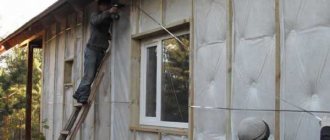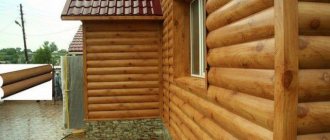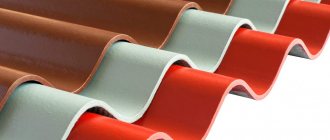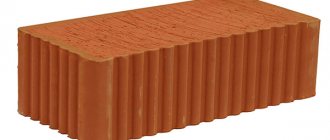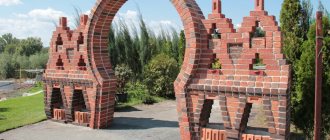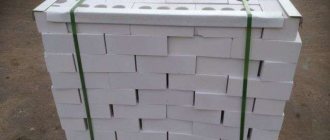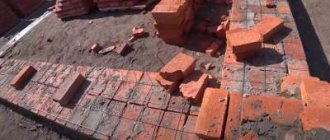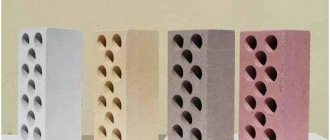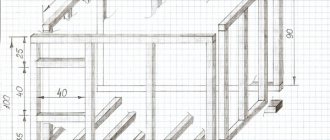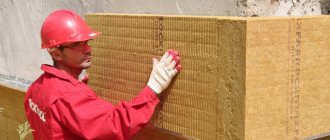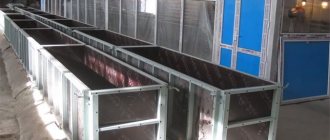Insulation of a brick house is carried out due to the high thermal conductivity of the durable material. For this, there are several well-proven technologies and many insulating materials: polystyrene foam, extruded polystyrene foam, mineral wool, facade thermal panels, polyurethane foam (PPU), etc. Let's consider the methods and popular heat insulators for brick facades, analyze all the intricacies of performing thermal insulation work, and learn the nuances both external and internal insulation of brick walls.
Main characteristics of materials for thermal insulation
A very important task when insulating a brick house is choosing a reliable and durable material for treating the outer part of the walls.
It must have certain characteristics that must withstand precipitation, high humidity, wind and frost, as well as heat. Therefore, it is important to consider the following characteristics when choosing:
Water absorption. It is better to give preference to materials with a low water absorption coefficient. Thermal conductivity. This is the main criterion when choosing insulation. The amount of heated air in the house that is lost in one hour per square meter of material with a thickness of one meter depends on it. It is this indicator that you should rely on when choosing the thickness of the insulation layer. The most suitable materials for this would be polystyrene foam and mineral wool. Flammability. This characteristic determines the danger of the material in case of fire. Thus, products can be divided into 4 classes according to this characteristic, and it is better to give preference to G1, which can go out without an open flame
For example, polystyrene foam boards have a high ignition rate, and if they are used for cladding a house, you should choose the C marking, which means self-extinguishing. Pay attention to the density, which determines the amount of additional weight on the structure. The lower the indicator, the lighter the material will be. Sound insulation level
Allows you to reduce noise penetrating into the building. Almost all materials for thermal insulation have this characteristic. Environmental friendliness. For exterior wall decoration, this criterion is not particularly important, since it determines the level of health safety of the material. However, it is still better to use natural rather than synthetic materials. Difficult to install. In the case of finishing it yourself, without the help of specialists, it is better to give preference to a simple and understandable technology for laying heat-insulating material.
Thus, the choice of material is a decisive factor, depending on which the final result will depend, as well as the service life.
What causes the need for insulation?
In addition to the main reason for insulating a brick house, there are additional ones that are also of no small importance.
Firstly, this is an increase in tariffs for utilities, so the first task is to use the already received heat economically. The less thermal energy is lost, which is spent on additional heating of cold walls, window slits, floors, ceilings, the less money you spend on paying for electricity, gas, water involved in your heating system. The floor and windows can be insulated from the inside, and the walls and ceiling can be insulated both from the inside and outside.
Secondly, wall insulation is the main source of the fight against mold, which is a formidable enemy of human health. Mold appears as a result of the temperature difference between the outer and inner sides of the wall, when the moisture contained in the air space of the room condenses on its inner part of the outer wall, favoring the growth of fungi and mold. In this case, it is recommended to insulate from the outside.
Insulation from the inside, how to avoid condensation
When it is not possible to install thermal insulation from the outside, it is installed from the inside. The main task is to avoid the appearance of condensation and moisture that is harmful to materials. Why do water drops appear on the wall?
This occurs when cold material comes into contact with warm steam from the room. In order for the wall to remain dry, it must be insulated from steam penetration. To do this you need:
use insulation with minimal vapor permeability, it is desirable that its value be lower than that of the wall; perform high-quality finishing from moisture-resistant plasterboard; use waterproofing fabric when installing insulation; reduce the humidity in the room using ventilation.
When choosing a material for thermal insulation, it is worth focusing on vapor-tight products: polystyrene foam, extruded polystyrene foam, polyurethane foam. It is possible to use mineral wool, but its installation will require a lot of effort:
it is necessary to fix the waterproofing to the wall surface; make a frame from wooden blocks impregnated with an antiseptic, or a galvanized profile; lay mineral wool, preferably with a glued layer of foil; perform a vapor barrier; install plasterboard trim.
Penoplex, consisting of foamed polyethylene and aluminum foil, can be used as a vapor barrier material. The canvases are laid end-to-end and fastened with staples; at the joints they are taped with foil tape.
Polyurethane foam is a synthetic two-component composition sprayed onto the wall. It is moisture-resistant, vapor-tight, and creates a monolithic surface without cold bridges. Insulation is used for any surface and effectively resists energy loss. A layer of material 5 cm thick is considered effective.
From the side of the room it is closed with a plasterboard partition. The disadvantage of this method is the high cost of services for applying polyurethane foam. Polystyrene foam and extruded polystyrene foam are more often used than other insulation materials for thermal insulation of walls from the inside. The work is divided into several stages. Preparation of the surface, including removal of the old finish, cleaning and priming with an antifungal agent. On insulation boards, glue is applied over the entire surface, and not pointwise as on the outside. For better adhesion to the wall, the surface of the polystyrene foam is pierced with a needle roller. There must be enough glue thick to fill small irregularities. The slabs are pressed tightly against the wall.
The installation is carried out end-to-end. After the glue has dried, after 3-4 days, the fastening is reinforced with umbrella dowels. The joints of the plates are treated with polyurethane foam. Using glue, a reinforcing mesh is attached to the surface of the insulation. Plaster is applied over the dried layer. Having compared the two methods, we can confidently say that external insulation is more appropriate. It significantly reduces heat loss and protects the walls of the house from premature destruction.
https://youtube.com/watch?v=6KlLQrO5-IUrel%3D0%26controls%3D0%26showinfo%3D0
- shop.rockwool.ru
- dachnoe-delo.ru
- remontami.ru
The importance of insulation
Brick houses are widespread all over the world, this is facilitated by the high strength and environmental friendliness of the material. At the same time, brick cannot be classified as a heat insulator , because it has increased thermal conductivity.
In what cases is this necessary, and when can it be avoided?
In cold regions, brickwork cannot retain heat in the room, and therefore there is a need for additional wall insulation.
Increasing the thermal insulation capabilities of a brick wall can be achieved by increasing its thickness. In the southern regions of the country, it is quite enough to lay 1.5-2 bricks and then you can do without insulation.
However, for areas where significant frosts are observed in winter, a wall thickness of 1 m or more is required , which is not feasible due to the weight of the structure, high costs and high labor intensity.
Another option is to use hollow bricks. Air significantly increases thermal resistance, which makes it possible to reduce the thickness of the wall. At the same time, the air gap plays its role for moisture penetration, which means that reliable thermal insulation is again required.
Thus, the need to insulate a brick house depends on the region and type of brick . You cannot do without it in cold regions, areas with high humidity and sudden changes in weather. If it is impossible to build a buried foundation, the thickness of the walls is limited, which also requires their insulation.
Why is it right to use insulation on external brick walls?
You can insulate a brick house from the inside, outside, or by using in-wall insulation.
In-wall insulation is used only for “well” masonry, when two brick walls are erected, between which a gap is left for laying insulation.
External insulation is most widespread. This is explained by the following circumstances:
- The role of internal and external thermal insulation differs significantly. Internal insulation is mainly aimed at retaining heat in the room, which increases the efficiency of the heating system. The outer layer prevents the penetration of cold from outside, which reduces the required power of the heaters.
- External insulation protects the wall from freezing. At low temperatures, the moisture accumulated in the material freezes, and this gradually destroys it from the inside.
- Location of the “dew point”. In the case of internal insulation, it is located indoors, and therefore condensation forms on the inner surface of the wall, which causes the development of mold and fungi. External insulation moves the “dew point” outside, reducing the risk of mold growing inside the house.
- External insulation does not change the useful volume of the living space , while internal thermal insulation, having a thickness of more than 10 cm, noticeably reduces it.
Despite certain disadvantages of external insulation (more expensive materials, seasonality of work), this method is recognized as more effective than internal insulation.
For the northern regions, an integrated approach is more suitable, i.e. double-sided wall decoration.
What insulation materials are available on the construction market
Today, a chain of construction supermarkets offers a wide selection of materials for insulating walls made of sand-lime brick. They all have their own characteristics that need to be known and taken into account in order for the insulation of the house to be of high quality and reliable.
- Mineral wool.
Scheme for insulating a wall made of sand-lime brick.
Despite the fact that this material has been used for a long time, it has not lost its popularity. Buyers prefer it for:
- optimal price;
- ease of installation;
- light weight;
- environmental safety;
- long period of operation;
- complete absence of an environment for the reproduction of rodents, fungus and mold.
Among the disadvantages of the material, the following indicators are distinguished:
- rapid absorption of moisture;
- easily ignites;
- does not retain its shape during deformation processes.
- Styrofoam.
Many experts suggest insulating sand-lime bricks using polystyrene foam. Its thermal conductivity coefficient is slightly lower than that of mineral wool. But among the advantages we can highlight the following:
- the material is resistant to moisture;
- easy to install, no special tools required;
- a light weight;
- environmental Safety.
Polystyrene foam has special water-repellent properties.
If a decision has been made to insulate a sand-lime brick house with polystyrene foam, then you need to know that it easily ignites and releases toxic substances when burned. There have been many cases where a fire ignites and spreads instantly, and the owners only have time to save their lives.
Expert advice! Today, the construction market offers a new type of foam, which has improved characteristics and greater fire protection.
- Expanded clay.
This material can be used to insulate a house during the construction phase. It is added to the cement mortar that will be used when pouring the floor and plastering the walls. Expanded clay has a lot of advantages that make it popular in the construction market:
- minimum weight;
- environmental Safety;
- mice do not gnaw it, fungus and mold do not develop in it;
- has high rates of heat and noise insulation;
- does not react with moisture, so it is ideal for the bathroom, kitchen, and toilet.
Among the main disadvantages is the high degree of dust emission.
- Polyurethane foam.
It is increasingly recommended to insulate a house made of sand-lime brick with polyurethane foam, since this material has the highest thermal insulation and strength. The material itself can be used in the form of slabs or sprayed onto walls. Polyurethane foam requires additional finishing, preferably with fire-resistant mixtures.
The main disadvantage is the high cost.
Scheme of wall finishing with polystyrene foam.
- Warm plaster.
This material provides the room with the highest thermal insulation values. Using warm plaster you can easily cover sand-lime brick. Among the main advantages are the following:
- the walls have high levels of heat, noise and sound insulation;
- the material is not subject to combustion;
- does not absorb moisture.
The main disadvantage that prevents the material from gaining popularity is the cost and methods of application to the walls. Warm plaster is applied using special automated equipment. Only a professional team has such systems, which will charge a lot of money for the work.
In addition, the maximum layer of plaster is up to 5 centimeters. The large mass of the layer that is applied to the wall requires the construction of a massive foundation or additional strengthening of an existing one.
Basement waterproofing.
- Fiberglass.
This material has excellent characteristics and is recommended by many experts. The main thing that everyone needs to remember is that this material should be installed only by professionals. It is toxic, therefore, if installed incorrectly, it can harm the health of not only the worker, but also everyone who will live in such a house.
- Ecowool.
It is used only for internal insulation. The material has optimal thermal conductivity and quickly absorbs moisture.
What will you need for your job?
First you need to decide what kind of material will be used to insulate the walls. The choice here is huge:
- Polystyrene foam is a material that is obtained by foaming plastic so that the resulting foam consists of 90% air and 10% plastic. This is the cheapest material that is easy to install and cut. 5 cm thick foam can replace 65 cm of additional brickwork, 1 m of concrete wall or 25 cm of wood.
- Glass wool is an elastic and durable material. It is obtained by processing glass waste. You cannot touch glass wool with your bare hands, much less work with it. Glass wool particles in contact with the human body or organs (eyes, mouth) cause severe irritation and redness of the skin, continuous coughing and can cause serious (sometimes even irreparable) harm to health.
Penoizol. It is poured through specially made holes in the brick between the outer and inner walls into the voids (from bottom to top).
The material is fireproof, retains heat well and does not harbor insect pests, mold or mildew. The service life of penoizol is about 50 years.- Polyurethane foam is easy to install even for those who are inexperienced in construction. It has low thermal conductivity, good sound insulation, water resistance and durability.
- Vapor barrier material - prevents the formation of condensation or steam on the walls, and, accordingly, their destruction.
- Ecowool. The material is sprayed wet onto the wall through a compressor.
- Expanded polystyrene or Pumpan is a dense and durable material that is not affected by solvents and alkalis.
- Mineral wool is fireproof, retains heat well and allows steam to pass through, and does not deform due to temperature changes.
- Basalt (stone) wool is strong, soundproof, fireproof, durable, and resistant to deformation.
Other consumables include:
- polyurethane foam,
- dowels and “umbrellas” (for foam plastic),
- reinforcing mesh,
- perforated metal corners,
- adhesive mixture for insulation,
- primer,
- lathing boards or metal profiles,
- plaster mixture,
- decorative plaster.
The use of these consumables depends on the selected material. For example, when using foam plastic, sheathing boards are not useful, but a starting metal profile is needed.
The amount of material depends on the area of the walls. The packaging usually indicates what area the material is designed for. You should always buy 5% more consumables, with the expectation that the material will be damaged or trimmed.
Electric and hand tools you will need:
- perforator;
- mixer or drill with a whisk for mixing the solution;
level;- rule;
- plumb line and fishing line for pulling a straight line;
- buckets;
- hacksaw for cutting material;
- a hammer or pick for knocking off uneven areas from the wall surface;
- spatula for applying and leveling the solution;
- knife (construction);
- grinding disc;
- brush or roller for priming and painting.
How to do it yourself?
A brick house is insulated according to one of the following schemes:
- install a ventilation façade;
- arrange a wet type façade.
The choice of one option or another depends on the insulation used and the external decorative material.
Stages of work when installing a ventilated facade
Brick walls do not require special preparation. Before starting work, you only need to take care of dismantling the wiring, drainpipes and install scaffolding.
Installation of a ventilated facade is carried out in the following sequence:
- Lay a vapor barrier.
- Install a frame made of timber or metal profiles.
- Thermal insulation material is attached.
- Waterproof the surface.
- After the facade is insulated and protected by waterproofing from the external environment, decorative wall cladding is performed.
This multi-layer design helps retain heat and works great in any region.
Installation of a wet facade
Before insulating a brick house using the “wet facade” method, it is necessary to prepare the load-bearing walls for work. They are cleaned of dust and dirt, and cracks are eliminated. In case of large deviations, the surface is leveled.
Installation is carried out in the following sequence:
- The cleaned surface of the walls is primed in several layers.
- A metal or plastic profile is installed around the perimeter of the house. It will serve as a support for the insulation boards.
- The insulation is glued to the wall. After the adhesive solution has dried, it is fixed with plastic dowels for strength.
- No earlier than a day later, the reinforcing mesh is laid. How to install it correctly? The mesh should not come into contact with the insulation. It is glued to glue with a layer of at least 2 mm. This makes it possible to significantly increase the adhesion between the insulation and the decorative finish.
- The reinforcing mesh is plastered with a rough layer.
- Next, the outer decorative layer is applied.
- The last stage of finishing work is painting the surface with facade paint.
Do-it-yourself insulation of a brick facade, performed in accordance with the technology, will allow you to effectively change its appearance, get rid of drafts and save on heating bills.
Advantages of external thermal insulation
Insulation of brick walls is divided into three types: external, internal and intra-wall. The last option involves constructing a building using well masonry and placing a heat insulator during the construction stage.
Internal insulation takes away the usable area of the premises, it provokes dampness in the walls and is not effective enough. Its advantage is the ability to complete the work at any convenient time and the low cost of materials. If you have a choice, you should give preference to external thermal insulation.
Among its advantages:
- The walls are protected from external influences, so they will last a long time.
- Significant reduction in heating costs.
- The opportunity to create the architectural design of the house to your liking.
- Absence of moisture, mold and mildew on the surface of the walls.
How to do self-installation?
Calculations
Even the most modern methods of insulating brick walls are available to ordinary people. The main condition for their use is accurate and competent design calculations. Only it allows you to simultaneously guarantee heat retention inside and minimal costs for performing work. In many cases, the simplest and most effective solution is to insulate walls with extruded polystyrene foam. Calculating the required indicators is quite simple.
For example, a wall is lined with full-weight bricks, each 30 cm thick. Heat transfer resistance is determined by dividing this thickness by the thermal conductivity of the material. This results in the difference between the normatively prescribed and actual thermal resistance.
Now you need to multiply this difference by the thermal conductivity coefficient of the selected insulation. The calculated result must, if necessary, be rounded to a whole value (since roll and slab thermal insulation is produced in multiples of 1 cm in thickness).
The insulation of the end wall in a house or apartment also has its own subtleties. In apartment buildings, such manipulation is rarely carried out outside, since it is very expensive and impractical. This must be preceded by a thorough search for possible cold bridges. As in other cases, it is recommended to use polystyrene foam, polystyrene foam or basalt-based materials.
Sequence of work
Ceramic brick not only insulates the facade, but also looks attractive and serves reliably. But this is carried out only on the condition that the masonry is done according to the rules, its seams are completely even and not dirty. The slightest cracks or stains of mortar on the blocks are unacceptable. The mixture for fixing the masonry is formed with M-400 cement and sand in a ratio of 1: 3.
It is worth noting that river sand cannot be used, because it leads to rapid shrinkage of the solution if a plasticizer is not added. It is not at all necessary to create a classic gray seam: a wide variety of pigments are readily sold in sets with facing bricks
The first step in the process will be preparing the waterproofing. For it they take either roofing material or thick polyethylene. Laying begins from the corners, leaving an air gap to the main wall (40–50 mm). The prepared solution should be relatively dense, but not too heavy for working with a trowel. A metal rod with a cross-section from 8x8 to 12x12 mm is placed on the front edges of the masonry.
Next to it, the solution should be level, and on the back side - about 1 cm higher. A vertical seam is created in a similar way. All stripes will need to be rubbed with a small brush after 120–180 minutes, covering any holes or nicks that are found. This will prevent water from getting inside from the external environment.
Important nuances
Before you insulate the walls in a brick house, you need to take into account certain features of the process and understand what they are.
In order to choose the right thermal insulation material, taking into account its technical characteristics, you should study a number of physical processes associated with this type of work.
The word “insulation” means a change in the performance of buildings in terms of thermal conductivity. A high reading indicates that a low quality thermal insulator was used and should no longer be used. Such work is carried out using insulating materials with a low level of thermal energy conductivity.
We know that brick stone is made from baked clay, which conducts heat well. A structure built from such material and without an insulating layer warms up and cools down quite quickly, and its temperature regime depends on the surrounding air. Note that clay has a porous structure and perfectly absorbs water, which under appropriate conditions tends to evaporate.
During the process of water evaporation, the temperature of the surface exposed to this phenomenon decreases. It turns out that a house made of brick stone, which is not a warm object anyway, cools down even more during evaporation. Using this property, on hot days you can cool a brick building that does not have insulation by opening access to the basement. The damp air flow rising from it fills the bricks with moisture, which gradually evaporates out. This process is comparable to the operation of an air conditioner.
Let's figure out how the insulation works correctly. In the material used for interior decoration, the movement of air masses is difficult. The air gap is a kind of barrier to heat flows. This principle is inherent in the design of a conventional thermos and double-glazed windows.
Effective protection against thermal energy loss is created by a layer of air located between the walls made of a special substance. The thermal insulation capabilities of the insulation, which are taken into account when purchasing the material, depend on the number of such interlayer partitions.
Insulating a brick house from the inside using modern methods shifts the dew point (this is the conventional name for the place where warm air is converted into condensation that accumulates inside) deeper inside the wall structures. It is necessary to move such a point outward as much as possible, away from the middle of the wall.
Such conditions can be achieved by insulating the walls from the inside. Naturally, such a solution will reduce the usable space of the room, which will greatly affect rooms with small areas. And yet, what is the best way to insulate walls from the inside?
How to insulate the outside of a house with your own hands using penoplex and polystyrene foam
Thermal insulation boards of polystyrene foam and penoplex are used mainly for insulating brick, block and concrete walls of houses. When the surface of the outer wall is prepared, they begin to insulate the house from the blocks from the outside
If foam plastic is used as an insulating material, it is very important to thoroughly dry the walls, otherwise the material may become saturated with moisture and lose its thermal insulating properties. This nuance especially needs to be taken into account before insulating a block house from the outside.
How to insulate a house made of foam blocks from the outside with foam plastic for subsequent finishing with decorative plaster? Sheets of foam plastic or penoplex are attached to the wall using a special adhesive. In order to glue the first row of slabs evenly, it is recommended to fasten the finishing strip along the bottom edge of the wall. After applying the glue, the sheets are pressed against the wall with little force. You can additionally fix the sheets using mushroom dowels in the center and corners of the sheet. Using a level and plumb lines, the plane of the applied foam layer is controlled.
Insulating a house with polystyrene foam according to the “wet facade” principle
This technology involves the use of either polystyrene foam or extruded polystyrene foam. The installation process of a “wet facade” is simple, but has certain nuances:
- The brick wall is pre-prepared. Dirt is removed from it, leveling is done, defects are corrected and primed.
- Next, a metal profile is taken and attached at the level of the base. This will be a beacon and a drip for moisture.
- Each slab is fixed in the corners and in the center.
- The first sheet is located in the lower left part of the wall, the next rows are placed offset to make the structure more stable.
- Once the insulation is fixed, a metal mesh is placed on top and plastered. A thin layer of solution is sufficient.
- Once the base coat has dried, decorative finishes can be applied.
What insulation materials are suitable for this?
Let's take a closer look at each of the suitable thermal insulation materials. Let's start with the cheapest, that is, glass wool.
Option one. Glass wool
A budget variety of mineral wool, so to speak. The material is quite dangerous, since when working with it, glass dust is released, which is extremely harmful to the respiratory system. When choosing this insulation, be guided by the fact that it will cost several times cheaper than its analogues (more on prices a little later).
Here are the main characteristics of glass wool:
- thermal conductivity index – from 0.029 to 0.041 W/m*K;
- the use of phenol-formaldehyde resin during the joining of fibers, due to which, in fact, toxic substances are released;
- the specific gravity indicator fluctuates between 11 and 25 kilograms per cubic meter;
- high danger to the human body (possible severe irritation of mucous membranes and skin);
- the vapor permeability indicator reaches 0.6 mg/m*h*Pa;
- the material is made from sand, limestone, broken glass, soda and borax;
- glass wool is a non-flammable material;
- high resistance to aggressive chemical environments;
- operating temperature – from minus 60 to plus 250 degrees;
- the fibers of the material do not absorb liquid at all;
- moisture absorption (if glass wool is briefly immersed in water) is approximately 0.8 kilograms per square meter.
From all that has been said above, we can conclude that glass wool would be an ideal insulation material if not for a number of harmful factors; more specifically, he:
- does not burn;
- resistant to high temperatures;
- moisture resistant;
- almost does not allow heat to pass through;
- not afraid of bacteria and fungi.
But health still comes first. That is why in a number of countries glass wool was banned from being used in civil construction. In short, in our case this material is not suitable at all.
Option two. Mineral wool
A common material, including as insulation for siding. It has all the advantages of the previous option, but it does not have its disadvantages. In addition, it is worth noting the long service life of mineral wool, reaching 70 years.
Over the years of operation, this insulation for the walls of a house outside under siding has shown itself only from the best side. You can easily install it yourself, but in the process you must strictly follow all the rules provided for by the installation technology.
In short, if you plan to use mineral wool to insulate walls under siding, you must take care to protect the material from getting wet. This can be achieved with the help of special membranes - moisture, wind and vapor protection (more on this a little later). The heat insulator in this case will be wrapped in a waterproof film. Manufacturers claim that such protection functions like a valve, since it only allows steam to pass out. Steam will not penetrate into the material from inside. What about the “breathing” of the walls, many will ask? The fact is that such “breathing” does not involve the movement of air through the walls; a ventilation system is used to ensure air exchange - even old log houses “breathed” only thanks to the stove draft, and not due to air penetration through the walls.
In short, mineral wool is a good option for thermal insulation of the outside walls of a house under siding. Go ahead.
Option three. Styrofoam
This material is characterized by a fairly low thermal conductivity (no more than 0.043 W/m*K), and therefore is rightfully considered one of the most effective modern thermal insulators. It is used in many areas, including for insulating the outside walls of a house under siding.
And it’s not surprising, because polystyrene foam has many advantages. So, it is quite easy to install, and it does not need waterproofing. It is also easy to work with polystyrene foam - it weighs little, is easy to cut, and does not emit any harmful dust.
Extruded foam plastic has a minimal thermal conductivity, but it:
- very durable;
- resistant to bacteria, fungi;
- not afraid of high humidity.
Its surface after installation will be protected by siding, and therefore the negative impact of the environment will be minimized. Therefore, extruded foam plastic is one of the best options for insulating the outside walls of a house under siding, especially since its modern varieties are safe both from a fire point of view and from an environmental point of view.
What does this look like in practice?
Now let's look at how to insulate a brick house from the inside, in practice.
If you chose expanded polystyrene, then your insulation is quite dense, 20-40 mm, and you can glue it directly to the wall. The denser part faces the inside of the house, as you remember, and then it can be finished off: wallpapering, plastering. By the way, if you are not insulating a house, but, for example, a bathhouse, but also made of brick, extruded polystyrene foam and other polymer materials will not be suitable here, since when significantly heated they will release toxic substances into the air. When insulating walls from the inside, start by treating the walls: they need to be leveled and primed with an antiseptic composition, which will guarantee the absence of fungi on the wall. Armed with regular tile adhesive or a special one for polystyrene foam, apply the adhesive composition with a notched trowel onto slabs that have been previously rolled with a needle roller, which will significantly improve adhesion. Glue the slabs tightly to each other, make a vertical spread between the seams of the rows. Wait until the glue dries, then fill all the resulting seams with silicone-based sealant. You must achieve maximum vapor tightness. You can cover the resulting surface with wallpaper, for which an aqueous solution of PVA glue will be sufficient. But if you want the inside of the house to have structural plaster, then you also need to reinforce the surface with fiberglass mesh, for which the same glue is suitable, and after the mesh has dried, proceed to decorative finishing.
How to insulate brick walls outside
Insulation for external thermal insulation of a house made of any material must meet a number of parameters, including:
- light weight;
- ease of installation;
- high physical and mechanical properties;
- affordable price.
Let's consider the most popular materials that meet these parameters and are most often used for insulation.
Insulation of a brick house with polystyrene foam
Foam plastic is one of the most affordable and popular materials, which for a long time was the only slab insulation on the Russian market. The advantages of polystyrene foam include the following parameters:
- Price. Polystyrene foam is the cheapest and most accessible insulation material. Its price is several times lower than its closest competitors.
- Ease of installation. Polyfoam is very light, so it is easy to install, lay and fasten.
- High thermal insulation properties. Convection heat transfer takes place in a single cell; heat transfer along the walls of the cells is insignificant due to their small thickness.
However, this material also has significant disadvantages, which often become a stumbling block when choosing this insulation:
- Fire hazard. Polystyrene foam burns well and quickly, releasing toxic substances into the atmosphere. When the outer cladding made of such material starts to catch fire, the flame can quickly spread to the roof of the building.
- Insufficient mechanical strength. Polystyrene foam is a fragile material, which causes inconvenience during its installation.
- High hygroscopicity, that is, the ability to absorb moisture. By absorbing moisture, the insulation loses its thermal insulation qualities, and when exposed to sub-zero temperatures, it simply collapses.
- Susceptibility to destruction by rodents. Rodents (rats, mice) very often live in polystyrene foam, and in a very short time they chew it out from the inside, forming entire colonies.
Insulation of a brick house from the outside with polystyrene foam
Extruded polystyrene foam and polystyrene foam are made from the same substance, but have different production technologies and, accordingly, different characteristics. Expanded polystyrene is produced by extrusion. It is produced by mixing polystyrene granules at elevated temperature and pressure with the introduction of a foaming agent and subsequent extrusion from the extruder. High-quality extruded polystyrene foam has a uniform, closed porous structure, with a cell diameter of 0.1-0.2 mm.
This technology gives the insulation the following advantages:
- High strength compared to conventional foam.
- Low thermal conductivity - 0.029-0.034 W/m•K. This quality allows the use of thinner sheets while maintaining high thermal insulation properties.
- Minimum water absorption. This parameter increases the durability of the material when exposed to precipitation, which allows it to be used even when insulating the foundation.
- Conditional non-flammability of extruded polystyrene foam. When exposed to open fire, such insulation begins to melt, but does not burn.
The disadvantages of extruded polystyrene foam include 5 times worse vapor permeability (0.013 Mg/(m*h*Pa)) than traditional foam. This increases the ventilation requirements for a house insulated with this material. Also, the disadvantages include a higher price. However, the use of expanded polystyrene in comparison with polystyrene foam for insulating a house from the outside is more justified.
Insulation of a brick house with mineral wool
Currently, the term mineral wool largely refers to stone wool - insulation obtained from molten rocks. The raw materials for the production of stone wool fiber are gabbro-basalt rocks.
Mineral wool is used for insulating brickwork using wet facade technology. This technology involves applying a layer of plaster mixture to the installed insulation layer, and then painting the facade.
Mineral wool has become very widespread in construction due to many positive qualities:
- Excellent thermal insulation qualities. The thermal conductivity of minavta is 0.035 - 0.039 W/m•K, which is the best indicator of all insulation materials after extruded polystyrene foam.
- Good vapor permeability, which is approximately 0.25 - 0.35 mg/m²•h•Pa.
- Mineral wool slabs can have different densities. Thus, for use in wet facades, products of higher density are used, which adds convenience to the installation and finishing of such a facade.
- Non-flammability. Stone wool is a completely non-flammable material. It can withstand temperatures up to 870 ºС, after which it breaks down and turns into hot dust.
This material has virtually no disadvantages, however, the cost of such insulation is higher than polystyrene foam.
The process of thermal insulation of the walls of a brick house with mineral wool is shown in detail in the video:
Insulation of a brick house with polyurethane foam
With the development of technology, new insulation materials with improved characteristics began to appear on the market. One of these materials was polyurethane foam. It is produced in different types, but for external insulation of walls or foundations, sprayed self-foaming polyurethane is used, the same as polyurethane foam.
This material is practically free of disadvantages. Polyurethane foam has low thermal conductivity (0.029 - 0.041 W/(m•K), low vapor permeability, good adhesion and waterproofing characteristics. Moreover, unlike polystyrene foam and expanded polystyrene, polyurethane foam is not destroyed by solvents.
The advantage of this type of thermal insulation is its ease of installation - polyurethane foam is applied to almost any type of surface, effectively filling all the cracks. However, the work requires special equipment and the involvement of trained specialists, which increases the cost of such services.
Sales statistics show that the most common insulation materials on the market are extruded polystyrene foam and mineral wool. These two materials have the best price-quality ratio, which finds a positive response from home owners who are planning external thermal insulation of walls.
Choosing material
Insulation is carried out according to a standard scheme: a multi-layer cake is assembled, in which various materials enhance each other’s technical characteristics and smooth out shortcomings.
What is the best way to insulate a brick house from the outside? The greatest demand is:
- Styrofoam;
- mineral wool;
- extruded polystyrene foam;
- polyurethane foam;
- warm plaster;
- thermal panels.
How and how to cheaply but effectively insulate a brick house can be decided after a thorough analysis of the technical characteristics of thermal insulation materials and engineering calculations.
It is necessary to pay attention to the following technical characteristics:
- vapor permeability;
- resistance to high temperatures and chemical elements;
- heat conductivity;
- degree of flammability.
Let's look at the main indicators in the table
| Material | Vapor permeability, Mg/(m h Pa) | Application temperature, °C | Thermal conductivity, W/(m °C) | Flammability class |
| Mineral wool | 0,53 | from -60°С to +180°С | 0,036-0,06 | G1 |
| Styrofoam | 0,23 | from -50°С to +70°С | 0,033-0,05 | G1-G4 |
| EPP | 0,015 | from -50°С to +75°С | 0,028-0,034 | G3-G4 |
| Polyurethane foam | 0,004 | from -100°С to +150°С | 0,025 | G4 |
| Warm plaster | 0,15 | No limits | 0,059 | G1 |
| Thermal panels | 0,05 | from –100оС to +150оС | 0,025 | G1-G2 |
What is the best insulation for walls? There is no clear answer to this question. To insulate brick walls from the outside with your own hands, the insulation is chosen based on the financial capabilities and personal preferences of the owner, the necessary characteristics of the material, as well as the season for finishing work.
Mineral wool
One of the most budget-friendly insulation materials is mineral wool. The increased interest of developers in this material is caused not only by cost, but also by unique characteristics.
Mineral wool is characterized by a number of positive qualities:
- has excellent thermal insulation properties and isolates the room from external sounds;
- promotes free air circulation and is a good steam conductor;
- resistant to most chemical elements;
- indifferent to temperature changes and their critical values;
- allowed for insulation of walls from the street and indoors.
However, this material absorbs moisture well. When insulating the external walls of a brick house, installing a vapor barrier is a mandatory step in the insulation process.
Styrofoam
One of the cheapest thermal insulation materials is polystyrene foam. It consists of sheets with a cellular structure of varying strength and density. Thanks to its light weight and convenient dimensions, it occupies a leading position among other insulation materials.
It has the following advantages:
- when used within certain temperature limits, it is resistant to moisture;
- has excellent thermal insulation and sound insulation qualities;
- does not release toxins into the environment.
This material also has disadvantages:
- it is easily destroyed under the influence of mechanical loads and weights;
- under the influence of certain technical liquids and their vapors, it easily loses its integrity;
- exceeding the permissible temperature level causes destruction of the material;
- releases toxic substances during fires;
- has low vapor permeability.
Despite the fact that polystyrene foam is not susceptible to microorganisms, if insulation technology is violated, it becomes a common cause of mold on load-bearing walls.
Extruded polystyrene foam
Insulation of brick walls from the outside is often performed using extruded polystyrene foam. The main advantages of the material include the following:
- light weight;
- increased resistance to wet environments;
- resistance to mechanical loads;
- excellent thermal insulation properties.
The main disadvantage of expanded polystyrene is its reaction to fire: at high temperatures it begins to melt and releases acrid smoke into the atmosphere.
Polyurethane foam
Polyurethane foam is a synthetic insulation with a cellular structure obtained by the interaction of polymers, various additives and carbon dioxide.
It has the following advantages:
- fits perfectly on a brick wall;
- tightly fills cracks and gaps;
- retains heat well indoors;
- does not allow steam and moisture to pass through;
- resistant to environmental influences.
However, under the influence of ultraviolet radiation, its technical characteristics decrease during operation. To avoid destruction of the material, brick walls require subsequent decorative finishing.
Warm plaster
A universal finishing material for external walls is warm plaster. It consists of sand, cement, adhesive base and various fillers. The service life of a plastered surface is decades.
Plaster performs several tasks simultaneously:
- protects the room from external noise;
- provides its thermal insulation;
- performs finishing functions.
It is resistant to the external environment and retains its original qualities throughout its entire service life. Thanks to the lime it contains, it perfectly protects brick walls from mold.
Thermal panels
Increasingly, thermal panels are being used to insulate country houses. This is a multi-layer structure made of foam insulation, a decorative layer and an adhesive layer.
Thermal panels have a number of significant advantages:
- They perfectly insulate the house and allow you to save on heating costs;
- withstands low temperatures down to -40 °C;
- are not afraid of precipitation and protect brick walls from environmental influences;
- durable and not subject to rotting;
- Thanks to the durable outer decorative coating, they are resistant to fire.
Before installing thermal panels, care must be taken to level the walls.
